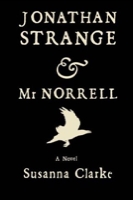I’m currently reading Susanna Clarke’s Jonathan Strange & Mr. Norrell, which I’d characterize as Jane Austen meets Neil Gaiman’s The Sandman.
Most reviewers have compared the book to the Harry Potter series, undoubtedly because the book is “about” magic, and takes place in England. This isn’t any more accurate than comparing Catch-22 to A Farewell to Arms simply because both are “about” war and take place in Italy. Stylistically, the books could not be farther apart. Where Potter is breathless and credulous (not unreasonable attributes for a public school coming-of-age story), Strange & Norrell is sophisticated and subtle. It’s quite enjoyable and would make a fine addition to anyone’s winter reading list.
Without going in to enough detail to ruin the plot, let me discuss the broad outline of the book. The year is 1806. For many years, magic had been a potent force in the North of England, with the coming of a fierce, faerie-raised youth, known as the Raven King, in the 1400s. Since the departure of the Raven King, magic has been in steady decline. At the time the book opens, there are no known practicing magicians in the realm. All is theory. Until, that is, a challenge is issued to a reclusive scholar, one Mr. Norrell. Mr. Norrell accepts, and literally makes the statues in York’s cathedral talk and sing. The notoriety gained from this demonstration helps establish Norrell in London society, and enables him to pursue his dream of restoring English magic. The novel is the story of dour, somewhat cautious Norrell and — later — his bolder and more impulsive protogé, Jonathan Strange, and how these two men work with, and against, each other.
It is very mannered novel. This isn’t an unreserved compliment. What readers like about Austen is not, in the final analysis, simply the look she gives into the Regency era. There are plenty of novels that do that, most of them unreadable. What makes Austen compelling, at least to me, is the drama. The drama comes because for Austen’s characters, finding a financially secure husband is a matter of life or abject poverty, not merely an issue of creature comfort. The seriousness with which Austen takes these issues is reflected in the moods of her works. Clarke’s writing is wrapped in the trappings of the day, but not actually concerned with them. There are many descriptions of London parties, eligible young gentlemen who have livings of 1000 pounds a year, etc., etc., but there’s no impact behind it. It’s not a life being lived; it’s a mere mise-en-scene.
That being said, it may just be a mise en scene, but it’s a fun one. What Strange and Norrell brings to the depiction of magic is a sense of true menace and mystery. It’s this element that some critics (notably Byatt) have found lacking in the Potter stories. The most apposite comparison of the magic in the novel would be that found in the works of Neil Gaiman. Gaiman’s magic, with its emphasis on the inhuman lands Faerie, and the dire consequences of transgressing against rules you may know nothing of. In the world of Strange and Norrell, magic is not merely an expression of forces beyond human power, but also of worlds beyond human morality. It is in this context that the quotidian setting of early 19th century Britain is effective. The fastidiousness of the actors serves to throw the wildness of the hidden world into sharp relief.
Strange and Norrell will appeal to those who like their books thick and fast. For although it is 800 pages long, it reads quickly. It’s not, in the final analysis, Great Writing; 10 years from now, I won’t be waking up in the middle of the night with my head ringing with the power of Clarke’s prose. You can be haunted by the magic of Rushdie or Garcia-Marquez, or oppressed and elated by the eloquence of Martin Amis, or hear echoes of Italo Calvino as you wander through daily life. Clarke’s writing will engender no such emotions. But that’s OK: I’m praising with faint damn. If I only read books by writers with the power of Garcia-Marquez I would read very few books indeed. Clarke is telling a great story, and telling it well.
Jonathan Strange & Mr. Norrell is almost certainly available at your local library, bookstore, or from amazon.com.






Ignore the overreaching Neil Gaiman blurb on the book. It’s a very good book, and while not great writing, has a vision of Faerie that is charged with menace and promise in a way seldom seen in fantastic literature. Right after I finished it, I was too willing to class it with LUD-IN-THE-MIST or LITTLE, BIG. While it isn’t of the stature of those amazing works, it is, as Peter says, fast and good and gets magic _right_.
Toasted cheese!
I picked up JS&MN at Borders a few weeks ago, but haven’t gotten to it yet. I’ve noticed that the online book cover images all have white text on black, but mine’s black on white — it was also shrink-wrapped for no reason that I could see. Did I accidentally pick up the equivalent of a comic book with a foil cover?